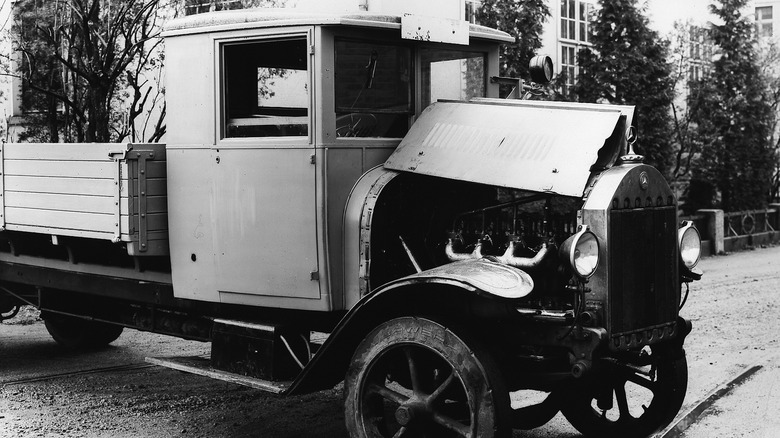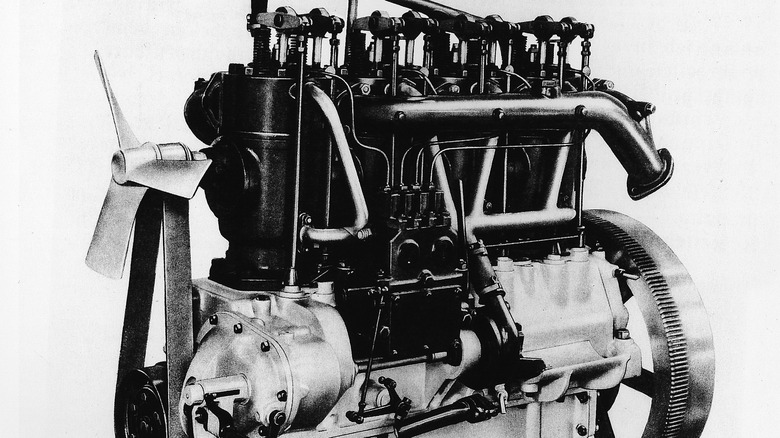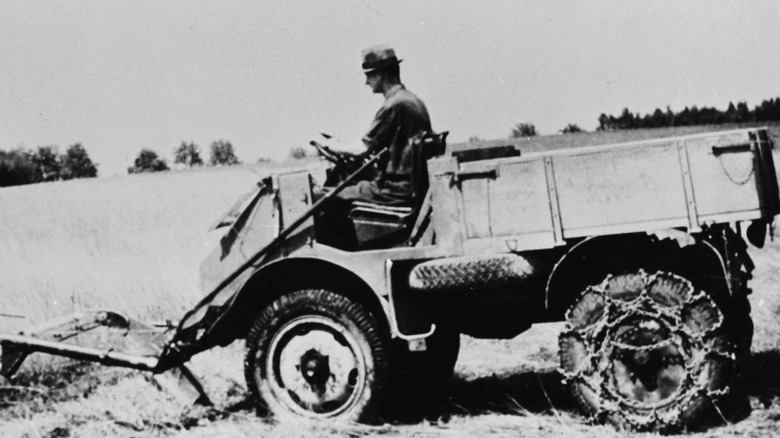The Fascinating History Behind The World's First Diesel Truck
Diesel and pickup trucks: It seems a patently obvious match, with the diesel engine beloved for decades due to its torque, fuel efficiency, and utility; and there's a reason why diesels are used in so many big rigs and agricultural vehicles. Like all great automotive titans today, the world of diesel trucks began small — but nevertheless purpose-built and quite capable. Before pickup trucks were in every other driveway in the United States and trucking carved its place in the logistics industry, such vehicles filled far more niche requirements. A pickup truck was more of an agricultural instrument than a passenger car, used as a workhorse around a farm.
Much like the modern gasoline-powered automobile itself, it was a German firm that presented to the world the first ever production diesel truck: Benz & Cie., one half of what would become Mercedes-Benz. First revealed in 1923, the original truck bore the designation of Benz Type 5K3, powered by an engine first showcased in April of that year called the OB 2. This was Benz & Cie.'s first attempt at a mass-production pre-chamber diesel, marking the beginning of a legacy lasting today.
The 5K3 itself has a deceptively complicated story, winning an arms race against MAN over a decade in the making. We've already delved into the anatomy of the first diesel pickup truck and what came after, but what events transpired to create it in the first place? What innovations did the truck and its engine's unique design bring to the table that enabled the viability of commercial diesel trucks?
Creating history, one diesel innovation at a time
Making a diesel truck requires two key ingredients: a diesel engine and a truck chassis. Following World War I, this proved a daunting task. The problem at the time was that modern fuel injection systems hadn't been developed yet; early diesels were ill-suited to commercial vehicle production because of their size and weight. These were ship and power plant generators not designed for high-speed operation in a car. Although the first diesel engine was created in 1897, it took decades before substantial improvements were made which allowed the engine to be miniaturized. The most substantial innovation came in 1909, with the advent of the precombustion chamber by inventor Prosper L'Orange.
Essentially, a precombustion chamber is like having two combustion chambers on top of one another. Combustion begins in this top chamber during the compression stage, before escaping downwards and generating the piston's power stroke. This early form of indirect injection helped to reduce noise and create a smooth-running powerplant. The OB 2 used this system to generate 45 horsepower at 1,000 RPM, but more importantly, to do it smoothly and efficiently. Eventually, these principles found their way into the world's first production passenger cars with diesel engines in the mid-1930s.
Concurrently, Daimler was testing its own version of air-injection diesel, in development from 1911 until its launch in late 1923. While both engines proved their value and both trucks debuted in the same year, the Benz design proved its superiority, and production of updated engines continued after the merging of Daimler and Benz in 1926.
A diesel legacy spanning over 100 years and counting
The original iterations of the Mercedes-Benz diesel truck didn't sell well despite improvements like a Bosch injection pump; Robert Bosch himself was an avid fan, however, even purchasing a Type 5K3 in 1924. Critics cited it as loud and harsh; it wasn't until the late 1920s that the pickup found its market in England, thanks to positive press releases. Mercedes-Benz capitalized on this uptick in Germany as well, campaigning the truck on various long-distance excursions all across the nation in the summer of 1929. These factors helped cement the Mercedes reputation, and spawned a fleet which resumed production following World War II with the Unimog, one of the most reliable classic vehicles of all time.
As for the truck's engine and its various innovations, you won't find any precombustion chambers on most modern diesel designs; today, direct injection is favored thanks to the increases in efficiency over indirect injection, and the technological improvements that allow the engine type to run smoothly.
However, it's the principle of the diesel truck itself that proved the most viable of all advancements. Diesel was originally conceived as a power generator, with gasoline and steam the predominant powertrains for motorized vehicles at the time. Appropriately enough, it took a while for the diesel-powered car to warm up — but once it did, it hasn't let us down since.


